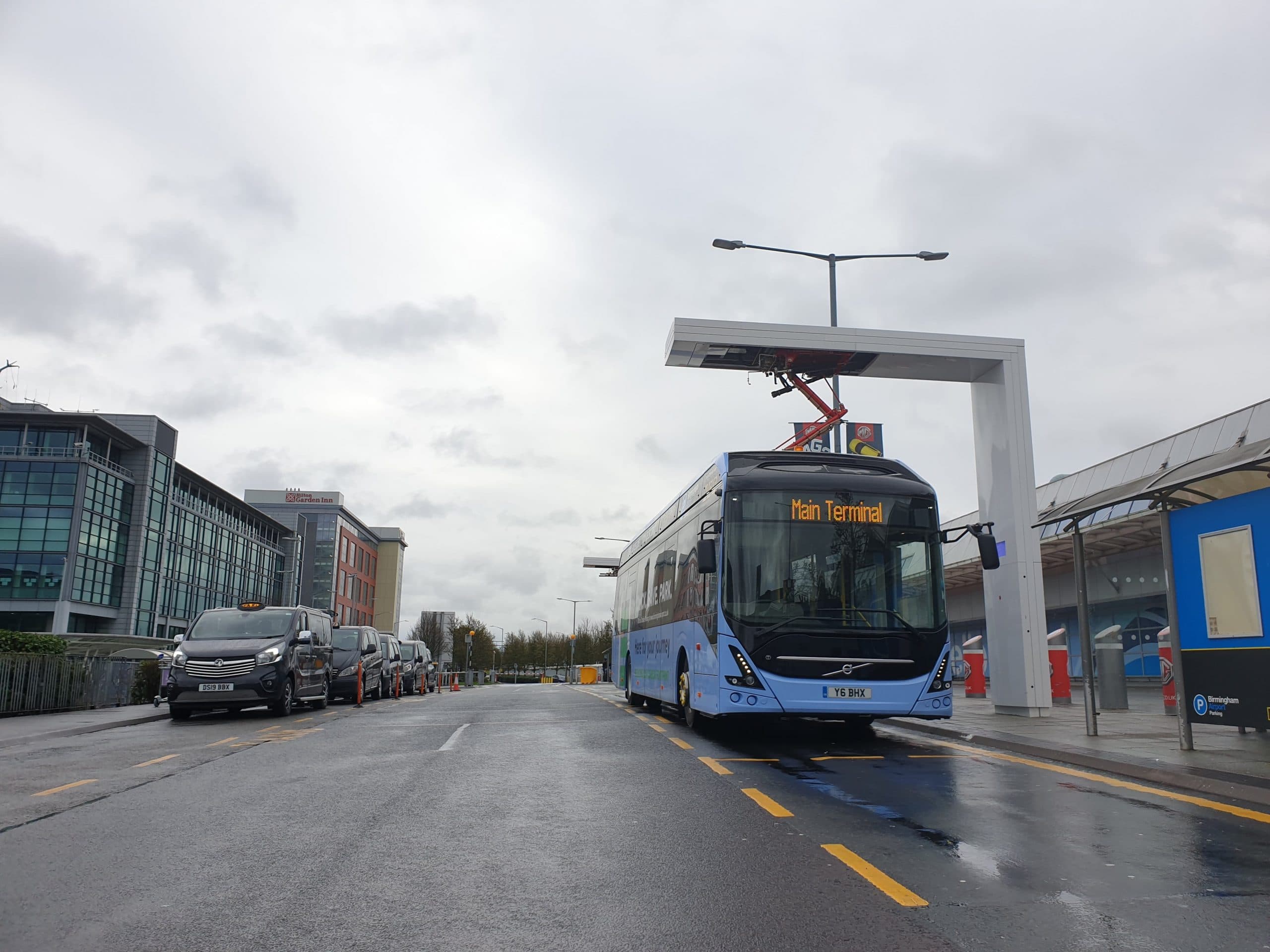LowCVP, Birmingham Airport and Volvo have examined why opportunity charging was the best fit for airport operations
The benefits and challenges of opportunity charging were examined by the Low Carbon Vehicle Partnership (LowCVP), Volvo and Birmingham Airport (BHX) last week.
BHX launched six single-deck electric buses in December last year, believed to be the first landside pantograph charged electric bus service introduced to any UK airport.
LowCVP hosted a workshop to examine development of the project, why pantograph charging was chosen and how the infrastructure was deployed, along with challenges and lessons learnt.
The challenges of opportunity charging
Procurement is one of the key aspects for operators when considering electric vehicles. Capital investment is significantly higher than diesel equivalents and so their application needs to make sense. The procurement process and the logic behind BHX’s fleet was covered in detail by Interim Fleet Manager Andy McDarmaid.
It is acknowledged that pantograph charging is not going to be an option for all operations, just as electric will fulfil a role for years to come alongside other technologies. For BHX, the decision to introduce a battery-electric fleet came as a result of a detailed tendering process which saw the opportunity charging system considered to be the best fit.
A crucial element of the project for BHX was that the delivery of the six new battery-electric buses was not a standalone project, Mr McDarmaid explains. The airport put together its own carbon reduction strategy while a fleet management assessment looked at upgrading vehicles “that people would relate most to in their day to day work”.
Out of the carbon reduction strategy came a whole range of projects and preemptive measures. For example, a strategic decision was made in anticipation of the growth of Birmingham’s Clean Air Zone. “We wanted to be doing something proactively, before that was incorporated into the airport site itself,” Mr McDarmaid adds. Fleet renewal was also a way to consolidate operational costs.
“We looked at the operational cost per mile of our existing fleet and found that the financial team agreed a capital spend on a vehicle. The operation team was then charged for the fueling of that vehicle, and the maintenance team was paying for the maintenance of it.
“There was no true cost at that time, going back three years, for how much per mile an individual vehicle was costing the airport. That was critical – once you start moving away from petrol and diesel engined vehicles, electricity costs are potentially offsetting the slightly higher capital cost for an electric vehicle.”
There were other factors to consider besides reduced operating cost and air quality, such as passenger perception and driver comfort.
“We were running a fleet of 2008 buses,” Mr McDarmaid explains. “They would break down frequently and suffered DPF issues. Things operators will understand if they have vehicles undertaking low-mileage, low-speed runs.”
Two key points allowed Mr McDarmaid to progress to procurement. The first was that BHX was looking to expand its passenger numbers between 2026 and 2030. “Considering the large capital expenditure on these vehicles, we did not want to have to go through a large procurement process each time,” he says. “The first thing we did was tender for a strategic framework for eight years.”
As a result any landside bus that BHX decides to buy, or any addition to the existing fleet, will not require an extended procurement process.
“We also wanted a full turnkey solution,” Mr McDarmaid adds. “We did not want to buy buses and look to a separate provider for charging infrastructure. We wanted one company providing a mobility service.”
That latter point, specifying Volvo’s maintenance and support package, is probably the most important factor in the whole process, Mr McDarmaid says.
The conclusions
Introducing an opportunity charged battery-electric fleet has generated much interest from other airports. Most have been to see how it works at Birmingham, Mr McDarmaid says.
Volvo Bus City-Mobility Manager Adrian Felton says that while Volvo was “nervous” about taking on full responsibility for the project, it was a fast journey, and has proven the viability of electrification. Equally, it will fit alongside other technologies.
“There are challenges, but electrification is possible,” Mr Felton says. “If we look at moving towards ZE public transport, even if we want to get there by 2050 it is a huge challenge.
“We know that opportunity charging works, but it will not be the solution for all operations.
“There’ll still be a place for other types of propulsion. There has to be.”
routeone comment
Operators will likely be looking closely at the application of new technologies, such as opportunity charging, with a close eye. It is a time where there is much change in vehicle technologies and committing to one solution may not be wise.
Pantograph charging may make sense for Birmingham’s airport fleet, but for operators running vehicles on rural routes, it would be impractical to say the least.
Workshops such as this one hosted by LowCVP are essential in providing as much information as is possible to those interested in reaching zero carbon. The deadline is fast approaching, and when pioneering measures are introduced, transparency is key if we are to cooperate and move into a clean, efficient future together.
Finding a solution that fits the operation is vital.
What is LowCVP?
Established in 2003, the Low Carbon Vehicle Partnership (LowCVP) is a publicly and privately funded partnership pushing for a shift to low carbon vehicles and fuels.
It has been working with the Department for Transport and Transport Scotland to fund low-emission coaches and buses for a decade, and has helped define standards manufacturers must meet.
Over 200 organisations are engaged with LowCVP.


























